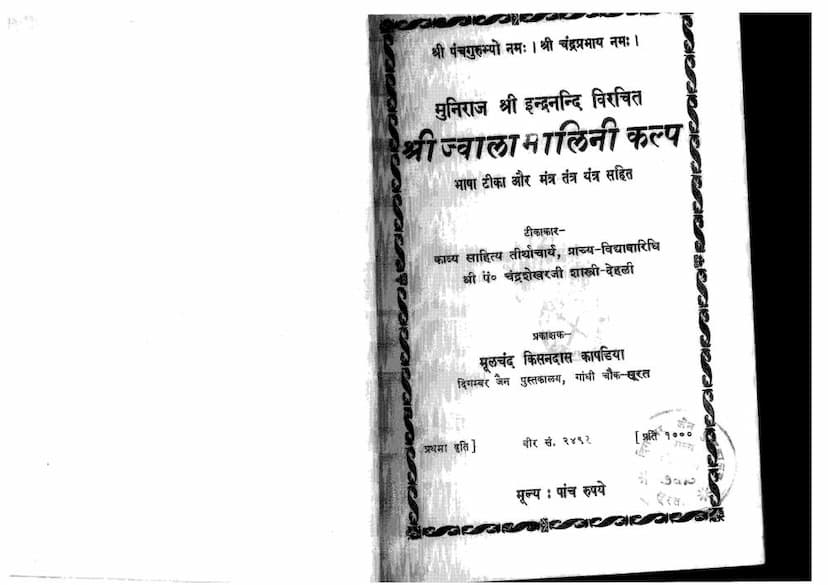Jwala Malini Kalpa
Added to library: September 2, 2025

Summary
The provided text is a portion of the "Jwala Malini Kalpa," a Jain scripture attributed to Muni Raj Shri Indranandi and translated and commented upon by Pt. Chandrashekhar Shastri. The publisher is Mulchand Kisandas Kapadia of Surat. The catalog link provided is for Jainqq.org.
Here's a comprehensive summary based on the provided pages:
Overall Nature of the Text:
The "Jwala Malini Kalpa" is a text belonging to the Mantra Shastra (science of mantras) within Jainism. It focuses on the propitiation and worship of the goddess Jwala Malini, who is an auxiliary deity associated with the 8th Tirthankara, Lord Chandraprabha. The text details various rituals, mantras, yantras (diagrams), and their applications for achieving desired outcomes, protection, and spiritual attainment. It is presented with a Hindi commentary and includes explanations of tantric practices.
Key Information and Content:
-
Author and Translator: The original author is Muni Raj Shri Indranandi (10th century CE). The Hindi commentary and explanations are by Pt. Chandrashekhar Shastri of Delhi.
-
Publisher: Mulchand Kisandas Kapadia, Digambar Jain Pustakalaya, Gandhi Chowk, Surat.
-
Historical Context: The text highlights that while other Jain mantra shastras were available, this particular work by Indranandi was not widely published until recently (the preface mentions a previous publication 13 years prior to the current one). The publication is a result of the efforts of the publisher and the dedication of Pt. Chandrashekhar Shastri who painstakingly prepared the manuscript with a Hindi translation.
-
Origin of the Cult: The text traces the origin of the Jwala Malini cult back to Shri Helacharya, a leader of the Dravidagana, who performed sadhana for Jwala Malini to help his disciple Kamala-Sri, who was afflicted by a Brahma-Rakshasa. This tradition was passed down to Indranandi.
-
Date of Composition: The text places Indranandi's work in the 10th century CE. Later, it provides a colophon mentioning the completion of the work by Indranandi in Shak Samvat 861 (939 CE) in the city of Manyakhet (modern Makhed), the capital of the Rashtrakuta kings. This confirms its antiquity, placing it in the first half of the 10th century CE.
-
Content Structure: The book is divided into ten chapters (Parichheda), covering various aspects:
- Chapter 1: Mantri Lakshana (Characteristics of a Mantra Practitioner): Details the qualities and ethical requirements for someone engaged in mantra sadhana, emphasizing purity, devotion, knowledge, and proper conduct.
- Chapter 2: Divya-Adviya Graha (Divine and Non-Divine Planets/Entities): Discusses the classification and characteristics of various entities (devils, spirits, forces) that can influence individuals and how to deal with them.
- Chapter 3: Sakalikaran Kriya (Body Consecration Ritual): Explains complex tantric procedures involving mantras and seed syllables for purifying and empowering the practitioner's body. This chapter includes numerous powerful mantras for controlling and neutralizing various adverse influences.
- Chapter 4: Mandala Adhikara (Diagrams and Mandalas): Describes the creation and use of various yantras and mandalas, such as the "Sarvato Bhadra Mandala," "Samaya Mandala," and "Satya Mandala," for protection and specific purposes. It also details the worship of guardian deities and celestial beings.
- Chapter 5: Bhuta Kampan Tail Vidhi (Oil for Stirring Spirits): Provides a detailed recipe and method for preparing a special oil believed to ward off or control spirits and negative energies.
- Chapter 6: Vashya Yantra Adhikara (Yantras for Attraction and Control): Focuses on various yantras designed for attracting or controlling people, animals, and specific entities. This includes yantras for protection, attraction, pacification of anger, and the subjugation of forces.
- Chapter 7: Vashya Tantra Adhikara (Tantras for Attraction and Control): Continues the theme of control and attraction, detailing various applications of yantras, mantras, and herbal preparations for achieving influence and prosperity. This includes specific recipes for perfumes, pastes, and oils for attraction and control.
- Chapter 8: Vasudhara Snan Vidhi (Vasudhara Bath Ritual): Describes a ritual bath associated with auspiciousness and prosperity, involving specific preparations, mantras, and worship.
- Chapter 9: Nirajana Vidhi (Aarti/Worship Ritual): Details the process of performing a ritualistic worship, likely involving symbolic representations and offerings to deities. It involves creating forms from specialized clay and performing specific rituals with them.
- Chapter 10: Shishya ko Vidya Dene ki Vidhi (Method of Imparting Knowledge to a Disciple) & Jwala Malini Anya Sadhan Vidhi (Other Sadhanas for Jwala Malini): This chapter covers the procedure for initiating a disciple into the practices of the Kalpa, emphasizing the importance of lineage and proper transmission of knowledge. It also includes specific sadhana methods for Jwala Malini, her stotra (hymn), and related practices.
-
Purpose and Application: The text aims to provide knowledge and methods for:
- Protection from negative forces, spirits, and afflictions.
- Attracting and controlling people, wealth, and desired outcomes.
- Achieving spiritual progress and liberation.
- Purifying the body and mind.
- Overcoming obstacles and enemies.
-
Emphasis on Ritual and Practice: The "Kalpa" is highly practical, providing specific instructions for creating yantras, reciting mantras, performing homas (fire rituals), and utilizing various ingredients.
-
Key Deities and Entities: Besides Jwala Malini, the text mentions numerous other deities and entities, including:
- The eight Matrikas (Brahmani, Maheshwari, etc.)
- Lokapalas (Indra, Agni, Yama, etc.)
- Various spirits, demons, and planetary influences.
- Lord Chandraprabha.
-
Shorter Stotras and Mantras: The text also includes the "Jwala Malini Stotra" and various specific mantras for different purposes, as well as a stotra in praise of Lord Chandraprabha.
In summary, the "Jwala Malini Kalpa" is a significant Jain text for those interested in the tantric and mantra traditions within Jainism. It offers detailed guidance for interacting with the divine and cosmic forces, particularly through the worship of Jwala Malini, for achieving worldly and spiritual benefits. The text emphasizes rigorous ritualistic practice, purity of intention, and adherence to the established lineage.